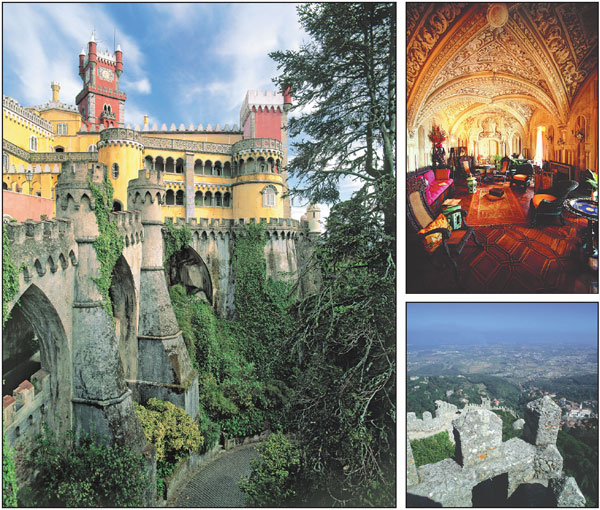Building love in Lisbon
Updated: 2016-05-11 08:04
By Erik Nilsson(China Daily USA)
|
||||||||
Amour and architecture infuse Portugal's capital with passion. Erik Nilsson explores the romanticism conjured by the cityscape that's in turn conjured by romanticism.
Lisbon is for lovers.
Of each other. And of cityscapes.
|
The Pena National Palace mixes styles of the neo-gothic, neo-manueline, neo-Moorish and neo-Renaissance architecture (left), and its interior is sophisticatedly decorated (top right). The Castle of the Moors (bottom right) defends its position among Lisbon's most ancient and esoteric constructions. Photos Courtesy of Tourism Portugal |
It truly is a romantic place - in every sense.
Its aesthetic appeals equally to cuddly couples and architecture aficionados.
Lonely Planet recommends it as the "perfect Valentine's date", in no small part because the legacy of Europe's second-oldest capital is shaped by the antiquated structures that straddle cobblestone lanes, engendering a vintage vitality.
The edifices that conjure this charm hike up the hills that hug the Tagus River that tickles the city's south. The knolls are snarled with flagstone streets that unravel from their peaks.
But perhaps the most striking feature of Lisbon's landscape is that its edifices are sheathed with miles of tiles that radiate colorful geometric patterns flamboyant enough to make a peacock blush. These testify to the area's Moorish legacy, although are sometimes tweaked to portray images rather than just configurations of shapes, as realistic depictions were banned under the Islamic empire.
Indeed, the passion Portugal's capital constructs isn't limited to buildings designed during the period when the romantic movement was most adored in the country.
It's a polyamory of neo-gothic, neo-Moorish, neo-baroque, neo-classical, art-deco, art-nouveau and generically medieval structures. They bestride flagstone streets along which century-old trams rattle, adding percussion to the city's romantic soundtrack.
Melody is underwritten by melancholy fado, a haunting folk genre performed by caped musicians that floats through ancient alleyways, bouncing off buildings like the anthems of gloomy ghosts. They're actually ballads of love.
Another cheek-kiss for kissy-face romantics - this charming miscellanea of buildings breaks against an ocean shore like the waves that, in the other direction, explode into aerosol against coastline cliffs.
Marinas bob with boats and a connect-the-dots of lighthouses trace the coastline. Palm fronds greet visitors with waves animated by sea breezes. Pinball games of seafowl play out in sapphire skies, punctuated with pearly clouds that project flashing apparitions of themselves on the roiling ocean.
The Castle of the Moors indeed defends its position among Lisbon's most ancient and esoteric constructions.
It was erected to protect against Christian invaders but never was besieged.
Ironically, it was abandoned after Christians conquered the settlement in 1147, having punctured the state security apparatus from elsewhere.
The stronghold was built by boring holes into rock that cleaved when wet wood was inserted and swelled.
King Ferdinand II, who reigned from 1837 to 1853, later built a second layer of walls to protect villagers who moved near the castle for safety.
The nature enthusiast planted 2,000 tree species in the area. In the spirit of romantic thought, these were never manicured but rather left uncultivated and are today wild woodlands of burgeoning biodiversity.
Again, the romantic movement was rooted in nature's spontaneity, childlike curiosity, adventure's adulation, unbridled imagination, and amorousness for its own toe-curling and hair-twirling sake. It seized life with more than an inkling of abandon - an ethos that lives on in the city today among its buildings of yore.
But before the era of love was a time of war.
The castle's tower was where the Moorish chief was stationed. He was essentially the king in a real-life chess game. Capture him and - well, checkmate.
Hence, the "betrayal door".
The fortification - which, as a stone bulwark, resembles small sections of China's Great Wall - had an escape channel for if defeat was imminent.
But the two-way tunnel isn't only a double-edged sword metaphorically. It could put you at the literal edge of a weapon.
A blade caressing a captured absconder's throat could turn a soldier more concerned with flight than fight into a stoolpigeon. They must reveal the shortcut to checkmate or be cut short themselves.
An equally explosive yet less dire reality of the design of the nearby Pena National Palace is that lunch was announced with an actual bang.
A balcony sundial not only homed rays to tell time but also concentrated beams through a magnifying glass to ignite gunpowder to declare chowtime. It's a pyrotechnic take on the dinner bell.
The compound Ferdinand II reconstructed on the ruins of a medieval monastery is ultimately a sanctuary of romanticism.
It, too, hosts a 96-hectare garden left to grow wild.
Indeed, Ferdinand II lives up to his name as the "artist king".
He not only drew the merman likeness of the Greek sea god Triton's statue above a main gateway but also rendered the complex into a shrine adulating romantic philosophy.
The palace is packed with the movement's major motifs - nature, kids and an amalgam of architecture that would otherwise make no sense.
Stone turtles crawl around elves. Carved vines wrap banisters.
Pillars and arches painted on the walls make the Arabic Room appear like a huge Middle Eastern complex - an embrace the muddling of styles, of exotic destinations and of illusion, since the modestly sized room appears to be a vast compound.
Indeed, the palace proves romantic beyond its architecture, as it's still a popular wedding venue.
Like the rest of Lisbon, Pena is a place dedicated to marrying different ways of thinking.
And that's what love is about, isn't it?
Contact the writer at erik_nilsson@chinadaily.com.cn
(China Daily USA 05/11/2016 page8)

 CPC creates cartoon to show how officials are selected
CPC creates cartoon to show how officials are selected
 Top 5 expected highlights at CES Asia 2016
Top 5 expected highlights at CES Asia 2016
 Business jet market hits air pocket
Business jet market hits air pocket
 Canada getting on top of Alberta wildfire, Fort McMurray off limits
Canada getting on top of Alberta wildfire, Fort McMurray off limits
 Young golfers enjoy the rub of the green
Young golfers enjoy the rub of the green
 71st anniversary of victory over Nazi Germany marked
71st anniversary of victory over Nazi Germany marked
 Post-90s girl organizes others’ messy wardrobes
Post-90s girl organizes others’ messy wardrobes
 Landslide hit hydropower station in SE China
Landslide hit hydropower station in SE China
Most Viewed
Editor's Picks

|

|

|

|

|

|
Today's Top News
Liang avoids jail in shooting death
China's finance minister addresses ratings downgrade
Duke alumni visit Chinese Embassy
Marriott unlikely to top Anbang offer for Starwood: Observers
Chinese biopharma debuts on Nasdaq
What ends Jeb Bush's White House hopes
Investigation for Nicolas's campaign
Will US-ASEAN meeting be good for region?
US Weekly

|

|
